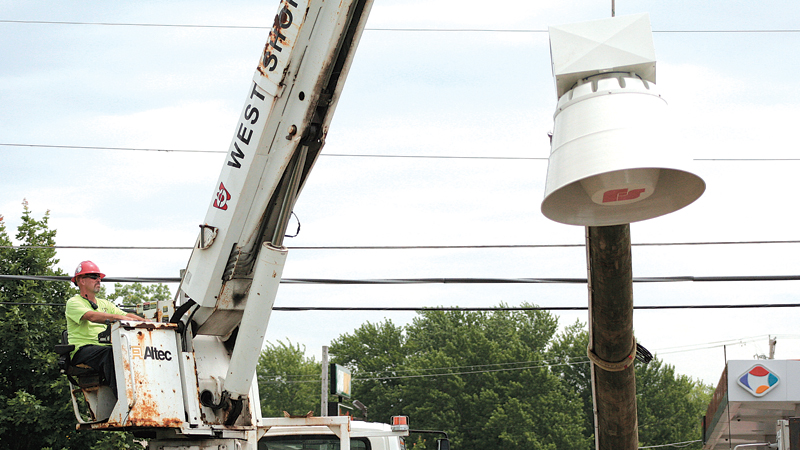WHAT WAYNEDALE RESIDENTS NEED TO KNOW ABOUT THE NEW OUTDOOR WARNING SIREN

For their own safety, all residents of the Waynedale area must understand that emergency managers refer to these devices as “outdoor warning sirens” for a reason. They are not designed to be heard indoors, especially not in today’s well-insulated houses with their windows closed. Unless you live very close to the siren, it will not wake you for a late-night or early-morning tornado warning. Even in the afternoon, when you’re awake, you probably won’t hear it inside your house when you have your windows closed and air conditioner running (again, unless you live very close). In your car, it won’t be loud enough to overpower your favorite music, unless you’re driving pretty close to the siren.
Therefore, if you rely too much on the siren to keep you safe from tornadoes, you will be at risk.
In 2012, a 16-year-old Alabama girl died after her family slept through a 4 a.m. tornado warning, learning of the twister only as it struck. Neighbors found the girl dead, 40 feet from what was left of her family’s three-story home, still lying on the mattress from her upstairs bedroom. The father commented to a reporter that they never heard a siren, an indication that they had unwisely expected to be awakened by one.
In the middle of the 20th century, outdoor warning sirens might have been the only way to alert people who weren’t already listening to radios or watching television. Fortunately, that’s no longer the case. Today, we have a myriad of much more effective options. These include smartphones (with their built-in Wireless Emergency Alerts and user-installed apps), weather alert radios, “reverse 911” systems like the Swift 911 service that Allen County recently implemented, and others. Yet some people remain dangerously reliant on sirens.
Even people who have alternate means of alerts are at risk, if they don’t heed them. Recently, a man told me how his wife reacted to the 2:31 a.m. March 1 tornado warning that included northern Allen County. They were in the path of the possible tornado and had gotten alerts from their smartphones and weather radio. But the woman wasn’t concerned enough to take shelter until she barely heard the sound of an outdoor warning siren more than a mile away — a sound she was lucky to hear at all. This is the kind of over-reliance on sirens that kills people.
Another way people unwisely rely too much on sirens is to fail to realize that the straight-line winds of a severe thunderstorm can do as much damage as a weak tornado. Remember the “derecho” of June 2012? The National Weather Service issued a severe thunderstorm warning that day, but Allen County does not sound outdoor warning sirens for severe thunderstorm warnings.
The second concern is desensitization. This occurs when people hear sirens so often, they begin to ignore them. It happened to residents of Joplin, Missouri, before the 2011 tornado that devastated that city, killing 158 people. It could happen to Waynedale-area residents, because the new siren will sound, even for storms that are far from Waynedale and moving away. For example, if a northeastward-moving storm begins to threaten Woodburn with a potential tornado, the siren in Waynedale will sound, even if Waynedale is in no danger at all. This is because Allen County does not currently have a way to activate sirens individually. If one sounds, all sirens in the county sound (excepts those in New Haven, which that city controls separately). The more times the Waynedale siren sounds when there’s no storm threatening Waynedale, the more likely are area residents to become desensitized and begin ignoring the siren they fought so hard to get.
So, to stay safe, Waynedale-area residents need to understand:
– They should not expect to hear the siren indoors and should not expect it to wake them at night (unless they live very close to it).
– They should not expect the siren to warn them of dangerous straight-line winds (like the derecho of 2012) if there’s no tornado warning.
– If they can hear the siren, they should not assume they are in danger. The warning might be for another part of Allen County. They should immediately seek more information from another source.
– They should have more modern and reliable ways to be alerted to weather hazards, including a weather alert radio, a smartphone app, registering for Allen County’s Swift 911 system, and staying tuned to local TV and radio stations when severe weather is forecast.
– The new siren alone will not keep you safe.
Jay Farlow is a volunteer storm spotter for the National Weather Service’s (NWS) SKYWARN® program, a role he has held for more than 30 years. He writes a blog that focuses on severe weather and weather safety topics and that the NWS has recognized as part of its Weather-Ready Nation Ambassador program. Farlow lives in northeastern Fort Wayne but grew up near Waynedale in the Lakeshore addition and attended Maplewood Elementary, Miami Junior High and Wayne High School. He is a former broadcast journalist who now works as an independent public relations consultant.
- Community Invited To Paint Rocks For Urban League Project - April 26, 2024
- The “Bad Guys” In Your Garden & What To Do About Them - April 26, 2024
- Why Voting In The Primary Election Matters - April 26, 2024


